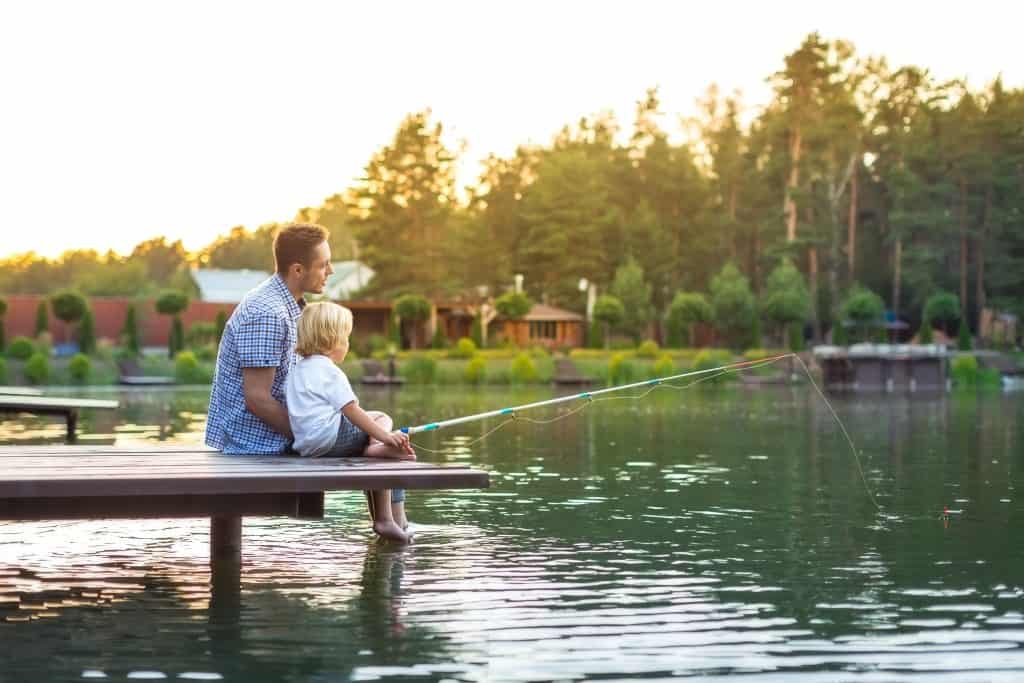
When I was thinking about fishing in a stocked lake, I wasn’t sure if it would yield better or worse results than a natural lake or river. To answer this question, I’ve looked around to find some of the best strategies for fishing at a stocked lake.
Is fishing easiest immediately after a lake was stocked? Generally, fishing is easiest and most target-rich right after stocking has occurred. Hatchery-bred fish are ignorant of many fishing strategies and will be closely grouped together, making them an easy catch.
Freshly stocked lakes can be a great place to catch a fish that hasn’t become too suspicious, and your chances of finding one are higher too! However, there are a few complications to targeting hatchery-bred fish, such as ignorance to different bait types, and competition from other sources.
Stocked Fish Behavior
The good and bad thing about going after stocked fish is that they have lived their entire lives in a comfortable, safe, non-threatening environment. This is a good thing for fishers because it means that they won’t have a natural suspicion of bright lures or overly convenient bait.
But it can also be a bad thing as well since it means that they won’t have some of the normal behaviors found in wild fish.
Because of these quirks, many stocked fish won’t pay attention to fly lures because that’s not the kind of prey that they’re used to. As they get used to their new surroundings and learn to find their own food, they will begin to expand their food range.
But if you’re fishing a freshly stocked lake with fly lures, chances are you won’t have as much success as with other types of lure or bait. This is because these fish have been fed aquatic food their entire lives, so they don’t have much experience in going after flies or surface level food.
Due to this feeding habit, there are certain kinds of lures or bait that will be more effective than others.
Bright colors and quick movements will easily draw the attention of hatchery fish. They’ll be looking for things that are active and seem alive. Because of this, colorful lures and spin fishing can be good tactics to use to attract stocked fish.
They will also be able to recognize the smell of real food, so bait fishing can be a good strategy as well. Fish who were raised in a hatchery will definitely recognize a worm or a grub when they see or smell it.
If you want to get the attention of freshly stocked fish, fresh bait is always a reliable method to use.
However, you should bear in mind that stocked fish aren’t necessarily dumber than wild fish. They still have instincts and can learn what to avoid, they just won’t know the difference between what’s real and what’s fake at first. They will quickly learn that not all food is safe, and will become harder to catch the longer they are in the wild.
In other words, they may be easy targets at first, but they won’t stay that way forever.
Another thing to know about stocked fish is that they won’t stay in one place for too long. Right after they are placed in a new environment, they will probably stay relatively close by.
However, if you go fishing a
Fish won’t get washed there against their will, because they can and will swim upstream. But just due to natural spacing processes, you’re more likely to find greater numbers downstream than at their original stock point if you wait for a couple of days.

Complications of Targeting Stocked Fish
The origin of the population isn’t the only factor you’ll need to keep in mind when you’re going after stocked fish. These fish have lived their entire lives in captivity and will be interacting with a natural environment for the first time.
This means that the environment will be interacting with them too! Natural predators of these fish will suddenly have a lot more prey to go after. Birds, bears, raccoons, bigger fish, and other carnivores could all be competing for this new flood of food as well.
If stocking fish is something that happens regularly, the base number of predators is likely to increase in response. If fish replenishment has become a common practice in the area for multiple years, the predator populations have probably risen to meet it.
There is also a chance that parasites, aquatic fungus, and disease could affect this previously sheltered population. They may not have the natural protection and defense that they would have if they had been in the environment since birth. While this shouldn’t discourage interested fishers, these risks should always be kept in mind.
There may be a ton of new fish right at the start, but nature will help compensate for this. Many locations stock fish multiple times throughout the year in order to keep the numbers high and densely concentrated.
Remember that the population won’t necessarily stay high just because of a new addition.
Just know that even if the stock seems infinite, there are multiple processes at work to keep the population in check. Predators, disease, and an influx of new fishermen can all keep large fish populations from getting too out of hand.
And speaking of interested fishers, you’re likely to have competition from other people if you’re interested in going after stocked fish. Recently stocked fish create a period of time where many people will be casting their rods and going after the new population.
Strategies for Targeting Stocked Fish
In order to avoid this (or at least lessen the impact), there are a few strategies you can take.
One is the tip listed above, which is to use bait and lures that hatchery fish will be interested in. This will give you the leg up over those who may be using fly lures. Spinning lures and fresh bait will all be very tempting to hatchery-raised fish.
Another strategy is to fish further downstream than where the initial stocking point is. The fish will be spreading out, so there’s no reason to fish just in the first place you saw them. This will also help spread out the number of fishermen in any one place so you won’t be interfering with one another.
And, last but not least, don’t worry if you don’t go fishing on the first day that the area has been stocked. Many locations will stock fish multiple times during the year, so you will have many chances. The fish will be around for a while and you will still have space and time to catch them in the future.
In fact, if the stocked lake or river is too crowded for your taste during the first few days, you can choose to avoid the initial rush and still feel confident that you can pull in a good catch.
That being said, if you do choose to go later, remember that the fish will have spread out and will be learning about different types of food and lures. If you wait until later, your strategy should shift a bit to account for this.
For instance, using fly lures may be a good idea, since the fish will be expanding their diet. They’ll be fending for themselves for the first time and will be a little more desperate for food.
It’s likely that bait and lures will still be effective, but flies might be beneficial at this point too.
Related Questions
What do stocked trout eat? Fish raised in hatcheries are often fed smaller fish, shrimp, large insects, and worms. They may also eat small zooplankton or surface insects, but these are not a large part of their diet.
What is the best time of day to fish for lake trout? During the summer, lake trout are generally most interested in eating during the early morning and late evening hours. In spring and fall, sunset is preferable.
What depth do trout feed at? Lake trout generally feed at a depth of 35-45 feet in the spring and fall months. During the summer they are more likely to be found at depths of 50-65 feet.
